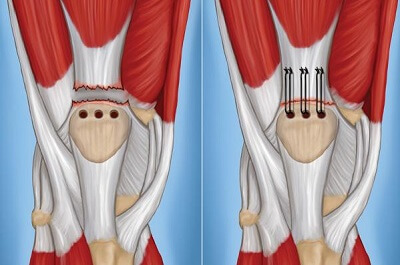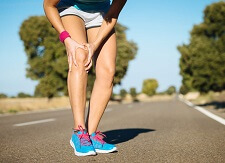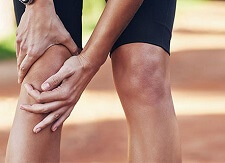- Home
- Common Knee Conditions
- Quads Tendonitis
Quadriceps Tendonitis
Written By: Chloe Wilson, BSc(Hons) Physiotherapy
Reviewed by: KPE Medical Review Board
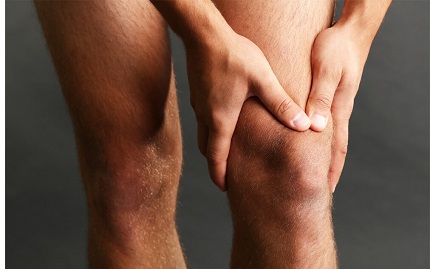
Quadriceps tendonitis is a common cause of activity-related anterior knee pain.
Also known as quadriceps tendinopathy, it is typically an over-use injury caused by too much sport, training errors, muscle imbalance and weightlifting, but can also affect non-athletes.
The main symptoms are pain and tenderness at the top of the kneecap that gets worth with exercise, and weakness.
When caught early, full recovery from quadriceps tendonitis knee pain may only take a few weeks, but if left to progress from inflammation to degeneration it may take 6 months to return to your pre-injury level, so early treatment is vital.
Where Is The Quadriceps Tendon?
The quadriceps is a group of four muscles found on the anterior thigh. They work together to straighten the knee, and control knee flexion when you are on your feet. They play an important role in activities such as running, standing up from a chair, climbing stairs, jumping, squatting and kicking.
The four quadriceps muscles are rectus femoris, vastus medialis, vastus intermedius and vastus lateralis.
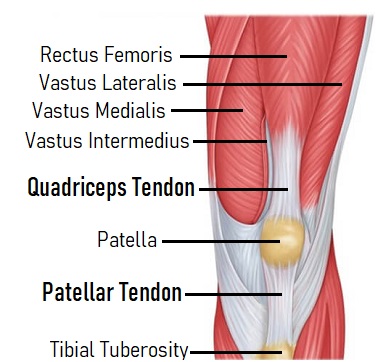
They combine together to form a common tendon in the lower thigh which wraps around the knee cap and extends down to the top of the shin bone, the tibia.
Whilst it is one continuous tendon, it is often referred to as two parts:
- Quadriceps Tendon: the portion above the knee cap between the quads muscles and the patella
- Patellar Tendon: portion below the kneecap between the patella and the tibia
Here, we will be focusing on the area above the kneecap and the area below the kneecap is covered in the patellar tendonitis section.
What Is Quadriceps Tendinopathy?
Quadriceps tendonitis is inflammation of the quadriceps tendon where it attaches to the top of the kneecap. It is the most common cause of pain above the knee.
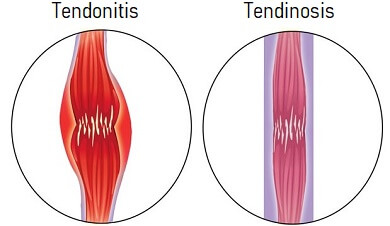
In the early stages of quadriceps tendonitis, strain and overuse results in small tears in the tendon.
The body attempts to heal itself by increasing the blood flow to the area to bring in the oxygen, chemicals and nutrients needed for healing.
But unless there is sufficient period of rest, further tears develop and the tendon gradually breaks down and thickens in response to the ongoing wear and tear, known as quadriceps tendinosis.
The terms tendonitis and tendinosis are often used interchangeably, but they do refer to different things:
- Quadriceps Tendonitis: early period after an injury (acute) where the main feature is inflammation. AKA quadriceps tendinitis
- Quadriceps Tendinosis: longer-term, ongoing injury (chronic) where the main feature is degeneration and scarring, not inflammation. AKA quadriceps tendonosis
The collective term for these is Quadriceps Tendinopathy, which can refer to either condition, and also encompasses damage to the patellar tendon below the kneecap.
Quadriceps tendinopathy can develop at the:
- Patellar Tendon Origin: 65% of cases are at the bottom of the kneecap
- Quadriceps Tendon Insertion: 25% of cases are at the top of the kneecap
- Patellar Tendon Insertion: 10% of cases are at the tibial tuberosity on the shin bone
Causes Of Quadriceps Tendonitis
Anything which places undue stress on the quadriceps tendon can lead to knee tendonitis. Quadriceps tendinopathy is typically an overuse injury, usually affecting athletes, but it can also affect non-athletes.
Common causes of quadriceps tendonitis are:
- Sports: Anything involving quick starts, stops and turns, running and jumping
- Training Errors: sudden increases in training levels such as frequency, duration and intensity
- Weight Lifting: repeatedly lifting heavy weights
- Footwear: lack of support and cushioning
- Muscle Tightness: inflexibility and tightness in the hamstrings and quadriceps muscles
- Altered Biomechanics: poor posture, altered foot, knee and/or hip position, patella maltracking
- Muscle Imbalance: anywhere from the hip to the foot
- Repetitive Actions: such as squatting, kneeling and jumping
- Aging: tendons get less flexible and take longer to heal as you get older. Also bone spurs often form which place extra friction on the tendon
- Obesity: a common factor seen in non-athletes experiencing quadriceps tendonitis
Risk factors associated with quadriceps tendinopathy include younger age, taller height and higher weight.
The sports most commonly associated with quadriceps tendinopathy are:
- Volleyball
- Basketball
- Handball
- Field Hockey
- Korfball
- Soccer
Of these, volleyball and basketball are by far the most common sports to result in quadriceps tendonitis knee pain.
Quadriceps Tendonitis Symptoms
The symptoms of quadriceps tendinopathy usually come on gradually over time rather than suddenly. Typical symptoms of quadriceps tendonitis are:
- Activity-Related Anterior Knee Pain: pain at the bottom of the thigh, just above the kneecap that gets worse with activity
- Localised Tenderness: discomfort when you press on the top edge of the kneecap
- Knee Swelling: around the tendon and kneecap
- Knee Stiffness: particularly when you first get up in the morning or after sitting down for a while
- Weakness: in and around the knee, decreased power during “push-off” phase of running/jumping
Symptoms of quadriceps tendinopathy can be classified into 5 stages:
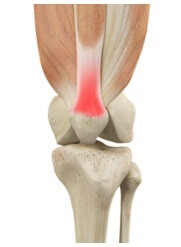
- Stage 0: No pain
- Stage 1: Pain only after intense sports activities. No functional impairment
- Stage 2: Moderate pain during sporting activities. No restriction on performance
- Stage 3: Pain during sporting activities with slight restriction on performance
- Stage 4: Pain with severe restriction of sports performance
- Stage 5: Pain during daily activities. Unable to participate in sports activities
Quadriceps Tendonitis Treatment
Early treatment for quadriceps tendinopathy can lead to faster recovery. Treatment for quadriceps tendonitis aims to:
- Reduce knee pain and inflammation
- Correct muscle imbalance
- Improve quadriceps function
Treatment options for quadriceps tendinopathy fall in to two categories, conservative (non-surgical) and surgical.
#CommissionsEarned from Amazon on qualifying purchases
Most people suffering from quadriceps tendonitis pain respond well to non-surgical treatment which typically includes:
- Rest: Avoiding activities that bring on your knee pain is vital. Modify your training so you are not exacerbating your symptoms e.g. reduce the frequency or duration of training sessions, or switch to things like cycling or swimming. In most cases, relative rest is best but in severe cases, complete rest may be necessary using a knee brace or splint
- Ice: Regularly applying an ice pack to the knee throughout the day, especially before and after sports, for 10-15 minutes can help to reduce inflammation and quadriceps tendonitis pain
- Physical Therapy: your physical therapist may use modalities such as ultrasound, acupuncture, electrical stimulation e.g. TENS machine and taping
- Massage: Deep transverse friction massage can be extremely effective in chronic cases of quadriceps tendinopathy. It helps to break-down adhesions and realign the collagen fibres in the tendon so that tendon heals properly. Another good option is to use a massage gun
- Bracing/Taping: Your therapist may tape up your knee to avoid overloading the tendon and prevent pain during day to day activities. Many people find wearing a knee strap particularly helpful, especially when they returns to sports
- Stretching Exercises: Knee stretches to improve the flexibility of the calves, hamstrings and quadriceps muscles to reduce the tension through the tendon
- Strengthening Exercises: Strengthening exercises for the quadriceps muscles, particularly the VMO muscles which control kneecap movement, hamstrings and glutes muscles, helps reduce the strain on the tendon. Eccentric training for the quads is particularly effective – this is when you strengthen the muscle as it lengthens rather than contracts
- Medication: your doctor may advise non-steroidal anti-inflammatory medication e.g. ibuprofen/Advil to help reduce quadriceps tendonitis pain and swelling in the knee
- Injections: In more severe cases, your doctor may recommend either corticosteroid or plasma-rich protein (PRP) knee injections for quadriceps tendinopathy that is failing to resolve
- Orthotics: Shoe orthotics help to address and biomechanical issues that may be contributing to your quadriceps tendonitis such as arch supports
Surgical Treatment
If the symptoms of quadriceps tendinopathy fail to improve with at least 3 months of conservative treatment, or the tendon has completely ruptured, then your doctor may advise knee surgery.
Surgery for quadriceps tendinopathy involves removing the damaged portion of tendon, repairing it and restoring the blood supply to the tendon, known as revascularisation.
Quadriceps tendonitis surgery is usually done arthroscopically, i.e. key-hole surgery, but in some case more extensive open surgery may be required.
If there is a complete quads tendon rupture, then surgery is needed to restore the extensor mechanism.
Holes are made in the kneecap with a special drill and sutures are places in the tendon.
The sutures are carefully tied onto the kneecap, through the drill holes, to ensure the right level of tension.
A knee immobilizer brace is usually worn after surgery while the quadriceps tendon is healing.
The sooner surgery is performed after injury, the better the outcome. LEARN MORE >
Most people go home the same day as their surgery, and should start physical therapy straight away for 6-8 weeks. Arthroscopic and open surgical procedures have shown good outcomes in people with severe symptoms of quadriceps tendinopathy where non-surgical treatment has failed.
Recovering From Quadriceps Tendonitis
Most cases of acute quadriceps tendonitis knee pain will settle within 6-12 weeks with non-surgical treatment. Chronic quadriceps tendinosis may take longer, typically 3-6 months. The sooner treatment begins once you notice symptoms, the quicker you are likely to recover.
You will probably need 6-8 weeks of physical therapy alongside your daily program of strengthening and stretching exercises.
As your strength, flexibility and endurance improves, you will be able to progress on to more challenging exercises and increase your activity level.
As the symptoms of quadriceps tendonitis begin to settle, you can gradually start returning to sport specific training, but start with low frequency, low intensity and short duration. Start slow and gradually build up, being guided by your knee pain – if it starts to hurt, that’s a sign you’ve done too much so back off a bit.
It is really important to avoid activities that aggravate your quadriceps tendonitis knee pain, and to continue you treatment until you have regained full range of motion, flexibility and strength in and around the knee. Failure to do so is likely to result in the symptoms coming back again.
Summary
- Quadriceps tendinopathy is typically an overuse injury from activities such as repetitive jumping, and sprinting
- It causes activity-related anterior knee pain with localised tenderness on the superior border of the kneecap
- In the acute phase, the main feature of quadriceps tendonitis is inflammation
- In chronic cases, the main feature of quadriceps tendinosis is degeneration
- Quadriceps tendonitis often co-exists with patellar tendonitis, aka Jumpers Knee, which occurs just below the kneecap
- Quadriceps tendonitis is most commonly treated non-operatively with a combination of rest, physical therapy, activity modification and exercises. More severe cases may require injections or surgery
- People typically make a full recovery from quadriceps tendonitis knee pain and are able to return to their pre-injury sporting level within 2-6 months
- Quadriceps tendonitis is just one possible cause of swelling above the knee
You might also be interested in the following articles:
- Pain Above The Knee
- Front Knee Pain
- Side Knee Pain
- Pain Below The Knee
- Burning Knee Pain
- Knee Range Of Motion
- Knee Pain On Stairs
- Knee Pain & Popping
- Swollen Knee Treatment
Related Articles
Last Updated: September 10th, 2025
Next Review Due: September 10th 2027

